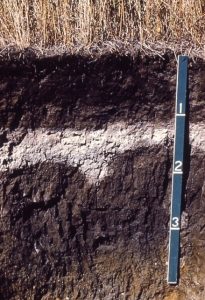2.4 Soil Profile Scale
Below the hillslope scale, soil profiles display vertical spatial organization and patterns spanning 10s to 100s of cm. The most significant patterns at this scale are the layers, or horizons, which together make up the soil profile and differentiate one soil type from another. Adjacent horizons differ from each other in physical and/or chemical properties, and the specific combination and sequence of horizons in a soil profile influence, and are influenced by, the presence and passage of water, energy, and living organisms. A soil profile of the Tetonka soil series shown in Fig. 2‑6 provides a dramatic example of the stark contrasts which can occur between adjacent horizons. The first, or uppermost, horizon is a >30-cm thick A horizon that is dark gray to black due to its high soil organic matter content. Just below that is an E horizon with a strongly contrasting light gray to white color resulting from the downward leaching, or eluviation, of clays, iron oxides, and aluminum oxides. Below the E horizon, is the Bt horizon which is marked by accumulation of clays leached from above. If you look closely, you can see evidence of prismatic type soil structure in this Bt horizon, suggesting the presence of yet another underlying level of spatial organization.


